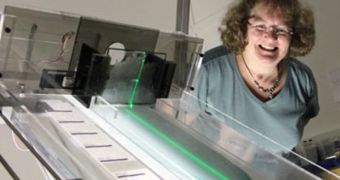Since 2005, a group of researchers and undergraduates at the University of California in Los Angeles (UCLA) have been conducting investigations into how sand and oil interact. With only modest funding, the team has been performing hands-on experiments on how the sludge moves on a sloped angle, using mathematical models to explain the phenomenon. But what was initially qualified as a pet project sprung into the spotlight recently, after the Deepwater Horizon semi-submersible drilling rig blew up in the Gulf of Mexico.
The director of UCLA’s applied mathematics program, professor Andrea Bertozzi, suddenly found herself in charge of an experiment that could help explain how oil will interact with the sands of the beaches that were affected by the BP oil spill. Thousands of barrels of oil had made their way to ecologically-significant beaches in a number of states, and the situation needed to be mitigated. And Bertozzi's experiments dealt specifically with this kind of scenario. The UCLA group was investigating the factors that determine the movement of oil sludges.
The team used tiny silica beads to emulate the behavior of sand. At first, they thought that figuring out the interactions taking place within the mixture would be easy, but the complex nature of the problem was soon revealed to them. When taking into account the size of the sand, the viscosity of the oil, and the angle of the slope, the mathematical equations aiming to predict the motion of the sludge suddenly became very complex. Over the year, this work received only little funding, from the Office of Naval Research, the US National Science Foundation (NSF) and the UC Lab Fees Research program.
When the Deepwater disaster happened, “I had the thought that we might start thinking about problems that were more directed at the oil spill,” the team leader says. She then applied for a rapid response NSF grant, and is now leading her team at the forefront of oil spill research. Hundreds of scientists from dozens of research team are also funded by the same type of grants. “Springboarding off our study, what we see happening depends on the angle of the incline, the viscosity of the oil and the amount of oil there in comparison to sand. We might potentially be able to predict how the oil is going to separate from the beach sand,” Bertozzi explains.

 14 DAY TRIAL //
14 DAY TRIAL //